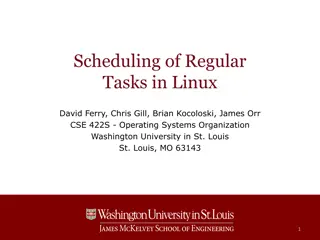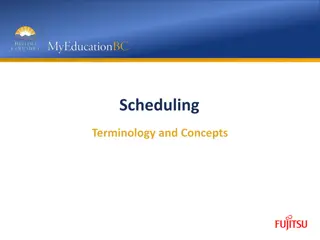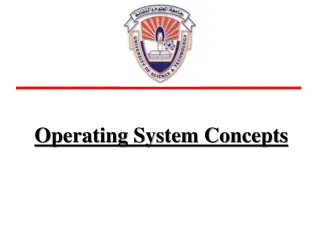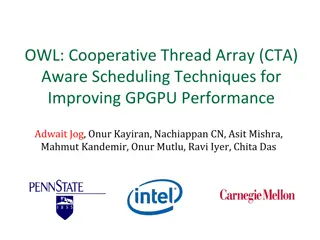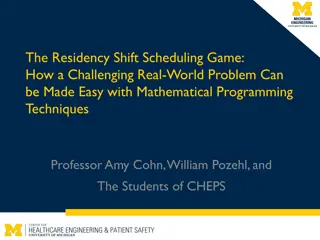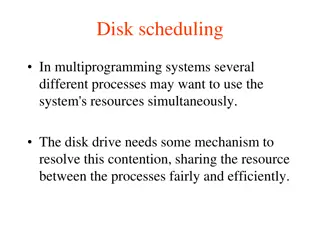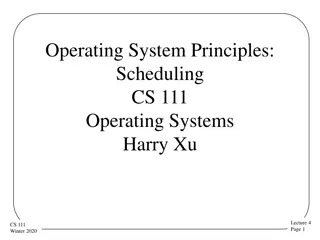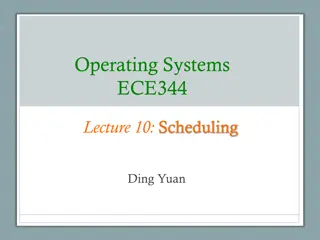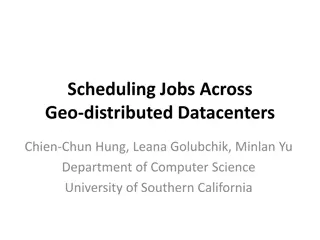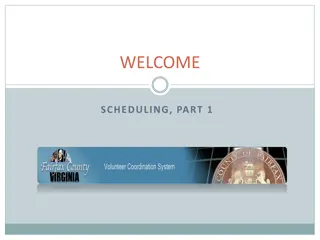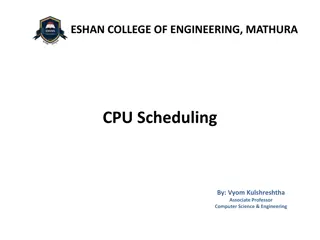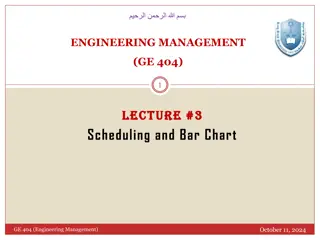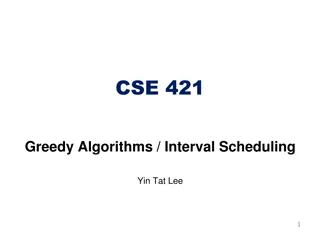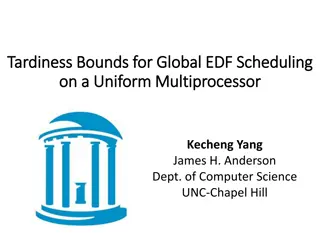
Scheduling Decisions in Process Management
Explore the intricate world of process scheduling in computer systems, where tasks are interleaved to optimize CPU efficiency. Learn about scheduler algorithms, key terms, system criteria, and behaviors affecting CPU utilization and turnaround time. Discover the critical moments for scheduling decisions to be made.
Download Presentation

Please find below an Image/Link to download the presentation.
The content on the website is provided AS IS for your information and personal use only. It may not be sold, licensed, or shared on other websites without obtaining consent from the author. If you encounter any issues during the download, it is possible that the publisher has removed the file from their server.
You are allowed to download the files provided on this website for personal or commercial use, subject to the condition that they are used lawfully. All files are the property of their respective owners.
The content on the website is provided AS IS for your information and personal use only. It may not be sold, licensed, or shared on other websites without obtaining consent from the author.
E N D
Presentation Transcript
SCHEDULING 19 April 2025
INTRO Interleave the execution of processes to maximize CPU utilization while providing reasonable response time The scheduler determines: o Who will run o When it will run o For how long 19 April 2025 2
SCHEDULING ALGORITHMS: TERMS Response time: minimize, for interactive users Turnaround time: average time for a job to complete Waiting time: minimize the average over processes Throughput: number of completed jobs per time unit 19 April 2025 3
SCHEDULING ALGORITHMS: TERMS Throughput number of processes completed per unit time Turnaround time interval of time from process submission to completion Waiting time sum of time intervals the process spends in the ready queue Response time the time between submitting a command and the generation of the first output CPU utilization the percentage of time in which the CPU is not idle 19 April 2025 4
CRITERIA BY SYSTEM TYPE 19 April 2025 5
SCHEDULING TYPES OF BEHAVIOR Bursts of CPU usage alternate with periods of I/O wait oCPU-bound processes oI/O bound processes 19 April 2025 6
CPU UTILIZATION VS. TURNAROUND TIME We have 5 interactive jobs i1 i5 and one batch job b Interactive jobs: 10% CPU; 20% disk I/O; 70% terminal I/O; total time for each job 10 sec. Batch job: 90% CPU; 10% disk I/O; total time 50 sec. Cannot run all in parallel !! i1..i5 in parallel - disk I/O is 100% utilized b and one i in parallel - CPU is 100% utilized 19 April 2025 7
CPU UTILIZATION VS. TURNAROUND TIME Two possible schedules: 1. First i1 i5, then b UT = (10x0.5 + 50x0.9)/60 = 83% TA = (10x5 + 60x1)/6 = 18.33sec. 2. b and each of the i s (in turn) in parallel: UT = (50x(0.9+0.1))/50 = 100% TA = (10+20+30+40+50+50)/6 = 33sec. 19 April 2025 8
WHEN ARE SCHEDULING DECISIONS MADE ? 1. Process switches from Running to Waiting (e.g. I/O) 2. New process created (e.g. fork) 3. Process switches from Running to Ready (clock.. ) 4. Process switches from Waiting to Ready (e.g. IO completion) 5. Process terminates Types of Scheduling: Preemptive scheduling: process preepmtion may be initiated by scheduler When for non-preemptive scheduling? only 1 And 5. 19 April 2025 9
FIRST-COME-FIRST-SERVED (FCFS) SCHEDULING Processes get the CPU in the order they request it and run until they release it Ready processes form a FIFO queue 19 April 2025 10
FCFS MAY CAUSE LONG WAITING TIMES Process Burst time (milli) P1 P2 P3 24 3 3 If they arrive in the order P1, P2, P3, we get: P1 P2 P3 0 24 27 30 Average waiting time: (0+24+27) / 3 = 17 19 April 2025 11
FCFS MAY CAUSE LONG WAITING TIMES (CONTD) Process P1 P2 P3 Burst time (milli) 24 3 3 If they arrive in the order P1, P2, P3, average waiting time 17 What if they arrive in the order P2, P3, P1? P2 P3 P1 3 0 Average waiting time: 6 30 (0+3+6) / 3 = 3 19 April 2025 12
(NON PREEMPTIVE) SHORTEST JOB FIRST (SJF) SCHEDULING The CPU is assigned to the process that has the smallest next CPU burst In some cases, this quantity is known or can be approximated Process Burst time (milli) 5 2 4 1 A B C D FCFS schedule A B Average waiting time: 8.75 D C 0 5 7 11 12 SJF schedule D B Average waiting time: 5.75 C A 0 1 3 7 12 19 April 2025 13
NON-PREEMPTIVE SJF: EXAMPLE (VARYING ARRIVAL TIMES) Process P1 P2 P3 P4 Arrival time 0 2 4 5 Burst time 7 4 1 5 Non-preemptive SJF schedule P4 P1 P3 7 P2 0 2 4 P3 5 16 12 8 P4 P2 Average waiting time: (0+6+3+7) / 4 = 4 19 April 2025 14
PREEMPTIVE SJF (SHORTEST REMAINING TIME FIRST) Process P1 P2 P3 P4 Arrival time 0 2 4 5 Burst time 7 4 1 5 Preemptive SJF schedule P2 P3 5 P1 P1 P2 P4 0 2 4 P2(2) 16 11 7 P1(5) P4(4) Average waiting time: (9+1+0+2) / 4 = 3 19 April 2025 15
ROUND ROBIN - THE OLDEST METHOD Each process gets a small unit of CPU time (time- quantum), usually 10-100 milliseconds For n ready processes and time-quantum q, no process waits more than (n - 1)q Approaches FCFS when q grows Time-quantum ~ switching time (or smaller) relatively large waste of CPU time Time-quantum >> switching time long response (waiting) times, FCFS 19 April 2025 19
COMPATIBLE TIME SHARING SYSTEM (CTSS) Assign time quanta of different lengths to different priority classes Highest priority class: 1 quantum, 2nd class: 2 quanta, 3rd class: 4 quanta, etc. Move processes that used their quanta to a lower class Net result - longer runs for CPU-bound processes; higher priority for I/O-bound processes for a CPU burst of 100 time quanta - 7 switches instead of 100 (in RR) 19 April 2025 20
USER-LEVEL THREAD SCHEDULING Scheduling within a quantum Different scheduling algorithms for threads/processes possible No way to preempt user threads Thread context switch much faster Application-specific scheduling possible 19 April 2025 21
KERNEL-LEVEL THREAD SCHEDULING Scheduling within a quantum Scheduler may prefer switches within same process Context switch more expensive A blocking thread does not block all process threads 19 April 2025 22
Three classes of threads Real-time FIFO o Have highest priority, can only be preempted by a higher-priority real-time FIFO thread Real-time round robin o Assigned time quantum Timesharing o Priorities 100-139 Priority determines the number of clock ticks (jiffys) assigned to a round-robin or timesharing thread 19 April 2025 23
24 19 April 2025

